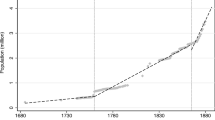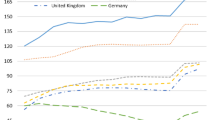Abstract
Past trends in fertility and mortality in China have led to an age composition that will age rapidly in the coming decades. In this paper we examine measures of population aging in China from 1953 to 1982, and then project population aging to the year 2050 using a cohort-components methodology. The projected measures of population aging that result from these forecasts are then decomposed into the relative contributions that are made to these changes by past, present, and future trends in fertility and mortality. Results indicate that China's population will age at an unprecedented rate over the next 70 years, both in terms of the absolute size of the elderly population and their proportion of the total population. At least 50 percent of the projected increase in population aging in China between 1980 and 2050 will be a product of the momentum for aging that is already built into the present age structure and vital rates. However, prospective trends in the measures of population aging become increasingly more sensitive to varying assumptions about fertility and mortality with time, and as older age groups are considered. This analysis provides the demographic basis for evaluating the possible effects of population aging on health care, social security, and other social and economic issues.
Similar content being viewed by others
References
Aird, J. 1986 Future Implications of Alternative Family Planning Policies in China. Center for International Research, U.S. Bureau of the Census, Washington, D.C.
Banister, J. 1986 China: Recent Trends in Health and Mortality. Center for International Research, Bureau of the Census.
Banister, J. 1987 China's Changing Population. Stanford University Press, Stanford, California.
Banister, J. 1988 Implications of the Aging of China's Population. Center for International Research, Bureau of the Census, Washington, D.C.
Banister, J., and S. Preston, 1981 Mortality in China. Population and Development Review, 7(1):98–110.
Bongaarts, J., and S. Greenhalgh 1985 An Alternative to the One-Child Policy in China. Population and Development Review 11(4):585–617.
Chen Muhua 1979a (For the Realization of the Four Modernizations, There Must be Planned Control of Population Growth), JMJP, August 11, 1979, p. 2 (English translation).
Chen Muhua 1979b Chen Muhua Outlines Significance of Planned Parenthood. FBIS, No. 251, December 28, pp. L7–9.
China Population Newsletter 1986 “Minister Wang Wei on Family Planning Policy and Population Aging”. Volume 3, No. 4, pp. 1–4.
Coale, A.J. 1964 How a Population Ages or Grows Younger in Populations: The Vital Revolution, ed. by R. Freedman, New York: Doubleday.
Coale, A.J. 1981 Population Trends, Population Policy, and Population Studies in China. Population and Development Review, 7(1):85–97.
Coale, A.J. 1987 Personal communication.
The Futures Group. 1987 Demproj. Version 2.62. Glastonbury, Ct.: The Futures Group.
Foreign Broadcast Information Service 1980 “CCP Central Committee Open Letter on Population Control.” No. 189, September 26, p. L1.
Grigsby, J. 1988 The Demographic Components of Population Aging. Pomona College. Manuscript under review.
Guanming Daily 1979 (The Strategic Task of Population Control Must be Accomplished), GMRB, Beijing, June 30, pp. 1, 3 (English translation).
Gui Shixun 1983 (Lecture VII: The Rate of Change of the Population Must Be Favorable to Social Development). Shehui (Society), No. 4, August 20, pp. 61–65 (English translation).
Hao Maishou, Wang Laihua 1987 (A Brief Discussion on the Prospect of Population Aging in China). Tianjin Social Sciences, No. 3, June 15, pp. 52–55 (English translation).
Hermalin, A.I. 1966 The Effect of Changes in Mortality Rates on Population Growth and Age Distribution in the United States. Milbank Memoral Fund Quarterly, 44(4):451–469.
Horiuchi, S., and S. Preston 1988 Age-Specific Growth Rates: The Legacy of Past Population Dynamics. Demography 25(3):429–441.
Hsiao, W.C. 1988 The Incomplete Revolution: China's Health Care System Under Market Socialism. Paper presented at the Fairbank Center for East Asian Research, May 13–15.
Hu Baosheng, Wang Yingzhi, Wang Wancheng, and Jiang Zhenghua 1980 (Fully Understand the Nature of Planned Population Control). RMRB, May 27, p. 5 (English translation).
Keyfitz, N. 1984 The Population of China. Scientific American, 250(2):38–47.
Kinsella, K. 1988 Aging in the Third World. CIR Staff Paper No. 35, Center for International Research, Bureau of the Census.
KMJP, 1979 (The CCP Kweichow Provincial Committee Circulates a Notice Throughout the Province. Two Prefecture and Hsien Leadership Cadres Who Failed to Practice Family Planning Have Received Severe Punishment), September 7, p. 2 (English translation).
Liang, J., Tu, E., Chen, X. 1986 Population Aging in the People's Republic of China. Social Science and Medicine, 23(12): 1353–1362.
Ma, Y. 1987 Family Planning and Population Aging Have No Quantitative Relationship. RKYJ, No. 2, March 29, p. 59.
Ming Bao 1979 The Future Policies Decided by the Central Work Conference are Policies on Economic Readjustment and Not Contraction. Foreign Broadcast Information Service, No. 119, June 19, p. L14.
Nan Zhongji 1986 On Population Aging in China. China Population Newsletter, 3(4).
Neugarten, B.L. 1974 Age Groups in American Society and the Rise of the Young-Old. Annals of the American Academy of Political and Social Science, September, pp. 187–198.
NFRB 1983 (Vice Governor Wang Pingshan Answers Reporter on the Questions Concerning Policies on Birth Control Techniques and Childbearing), May 15, p. 2 (English translation).
Qiu Jianwei 1984 (To Recognize Fully the Importance and the Urgency of China's Population Aging Problem). RKYJJ, No. 6, December 25, pp. 28–33 (English translation).
Shryock, H.S, and J.S. Siegel 1980 The Methods and Materials of Demography. Washington, D.C.: U.S. Government Printing Office.
Song Jian, Ti'an Xueyuan, Li Guangyuan, Yu Jingyuan 1985 Scientists Predict Various Rates of Future Population Growth. Reported by Yu Zhenpeng, Foreign Broadcast Information Service, No. 033, February 15, pp. L11–13.
Tian Xueyuan 1980 On the Question of the Growing Percentage of Old People. Foreign Broadcast Information Service, No. 83, May 14, p. 67.
Tian Xueyuan 1984 On Changes in the Age Composition of the Population and Policy Options for Population Planning. Social Sciences in China No. 3, pp. 191–206.
Tao Liqun 1984 (The Problem of Aging of the Chinese Population), Society No. 2, April 20, pp. 107 (English translation).
United Nations 1982 Demographic Indicators of Countries: Estimates and Projections as Assessed in 1980. New York: United Nations.
United Nations 1986 World Population Prospects: Estimates and Projections as Assessed in 1984. New York: United Nations.
U.S. Bureau of the Census 1988 Statistical Abstract of the United States, U.S. Department of Commerce, U.S. Government Printing Office, Washington, D.C.
Wei H. 1987 Growth of the Aged Population in China: Trends and Policy. In Aging China: Family, Economics and Governments Policies in Transition. J.H. Schultz and D. Davis-Friedman, eds. Washington, D.C.: The Gerontological Society of America.
WHP 1979a (Several Regulations of the Shanghai Municipal Revolutionary Committee Concerning the Promotion of Family Planning). Family planning regulations passed by the Fifth Plenary Session of the Shanghai Municipal Revolutionary Committee, August 22, p. 2 (English translation).
WHP 1979b (Population Control is a Strategic Task of Importance), June 30, p. 1 (English translation).
Wu, Yuanjin and Xu, Qin 1987 The Impact of an Aging Population on Socio-Economic Development and Families in China. In Aging China: Family, Economics and Government Policies in Transition, J.H. Schultz and D. Davis-Friedman, eds. Washington, D.C.: The Gerontological Society of America.
Wu Changping 1984a Problems of Old Age and Our Countermeasures. FBIS, JPRS-CPS-84-065, October 2, pp. 24–28.
Wu Changping 1984b (The Two Problems Which We Should Pay Attention To). Economic Digest, No. 4, p. 58 (English translation).
Wu Changping 1985 The Development Strategy Has to Be Based on Our Population Problem. JPRS-CPS-85-041, May 7, pp. 56–66.
Wu, I. 1986 Aging in a Changing Population, China in the Twenty-First Century. Unpublished manuscript.
Xu Qin 1985 Analysis of the Aging Process and Characteristics of China's Population. Renkou Yanjiu (Population Research) No. 6, November 29, pp. 28–30 in FBIS, JPRS-CEA-86-080, June 25, 1986.
Yu, Yuen-Chung and S. Horiuchi 1987 Population Aging and Juvenation in Major Regions of the World. Paper presented at the 1987 Annual Meetings of the Population Assocation of America, Chicago, Illinois.
Zhao, L., and C. Jiang 1986 (Some Thoughts on the Problem of Population Aging), JJWT (Problems of Economy), No. 12, pp. 58–59 (English translation).
Zhao, G. 1979 (The Promotion of the One-Child Couple is an Effective Way of Levelling Birth Peaks). Sichuan University Journal, Philosophy and Social Sciences Edition, Serial Monograph No. 3, pp. 40–45 (English translation).
Author information
Authors and Affiliations
Rights and permissions
About this article
Cite this article
Grigsby, J.S., Olshansky, S.J. The demographic components of population aging in China. J Cross-Cultural Gerontol 4, 307–334 (1989). https://doi.org/10.1007/BF00120576
Issue Date:
DOI: https://doi.org/10.1007/BF00120576




